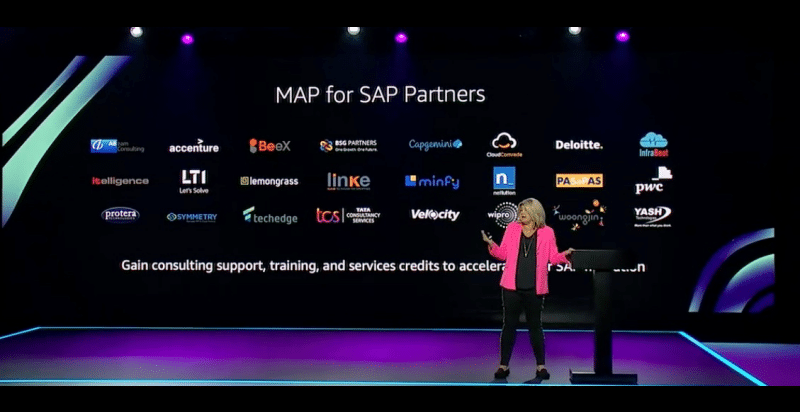With re:Invent kicking off today Andy Jassy opened up with the usual quickfire volley of platform updates and company headlines. Below are the key summary areas and new release topics of interest to us in the SAP-Centric universe:
AWS Company positioning:
- $46Bn revenue run rate, that’s 29% Y/Y growth since 2019, an immense $10Bn increase in just 12 months.
- AWS now the 5thlargest IT company globally operating a total of 45% of the Cloud market.
- COVID has attributed as a key cloud accelerator in 2020
Key callout regarding Reinvention culture drivers from AWS’s perspective over the last year. Interestingly these are predominantly leadership focused vs. technical:
- Leadership will invent and reinvent as required, again highlighting that innovation and modernization must be supported top-down to be successful
- Acknowledgment you can’t fight gravity – the inevitable rate of change. Those that resist evolution ultimately end up holding up company evolution
- The talent that’s hungry to reinvent. Ripping up what you’ve already developed is tough which is one reason why new talent tends to be more disruptive. New talent don’t have the attachment to the existing technology
- Solving real customers problems with builders yields the most beneficial results
- Speed – Adopting quickly, waiting for results is challenging accelerating to catch up to the present
- Don’t complexify, over-engineering is a risk
- Use the platform with the broadest and deepest set of tools. We see this at Lemongrass with the race to the bottom in current sales cycles rather than organizations selecting the most innovative platform for the Enterprise
- Pull everything together with aggressive top-down goals. Without goals, you can’t measure success (or failure)
Lemongrass’s most relevant updates for SAP workloads:
- New EBS! GP3 has been released, with +20% performance improvement and the ability to provision IOPS or throughputs as required without having to add additional capacity. This fixes the traditional problem we’ve seen with requiring extended striping or having to over-provision to meet the throughput on more intensive SAP workloads. Large stripes also add complexity with management, resiliency, and backups. GP3 is 4x the throughput with 16,000 max IOPs.
- AWS announced Io2 Block express, which provides 256k IOPs and throughputs of 4000MB/s of capacities up to 64TB which can be scaled to exactly the capacity required. This provides the SAN performance without the management headaches that can drive operational overheads. AWS also mentioned that Fast Snap restore, and Elastic Volumes are also coming later in 2021. This update will be immensely useful for intensive workloads like those we see in HANA.
- Aurora Serverless V2announcement is a big update enabling fine-grained scaling in real-time originally was between 5-50 seconds. The nature of being able to do this in a fine-grained manner makes scaling far more efficient. It’s also been updated to support multi-AZ models enabling automatic high availability. Whilst only Hybris is currently supported in the SAP stack for Aurora, this does enable quite a significant update as further SAP applications become supported on AWS native serverless DBs.
- New AWS DevOps CodeGuruservice: Start update that uses ML to automatically detect operational issues and recommend actions, for example, database memory leaks, code updates, IO utilization, compute under-provisioning, missing or incorrect alarms. The tool also makes remediation action recommendations.
Notable platform updates:
- On-demand macOS released today specifically for macOS development and testing – dead useful for multi-OS testing of end-user experiences.
- Graviton2 expansion continues at a pace, C6gn with Network enhancement and C6g released on Graviton2 is still driving 40% price performance vs Intel/AMS powered chips for these larger machines. Powerful platforms to consider for non-SAP applications being migrated as part of the landscape transformation.
- AWS also launched a new chip called Trainium, a highly cost-effective chip for ML (Pytorch, Tensorflow, etc) which will be available as an EC2 instance as well as Sage maker.
- Big updates on Containers this year:
- A new ECS anywhere release enables containers to be run on-premise as well as in AWS, this concept has also been extended into the second release in this area, EKS anywhere again enabling K8s clusters to be run on-premise or AWS.
- Lambda container support was also announced so now we can build lambda-based applications using existing container development workflows.
- Hybrid Cloud has seen some key updates to provide broader options that Outposts can currently serve- great for SAP manufacturing or Statutory on-premise requirements
- Outposts also had a large update for 2x new server solution designed for smaller physical deployments, a 1U & 2U model sizes designed for smaller locations that require an edge location in space-limited locations.
- 3x New local Zones also have been launched in Boston, Houston, and Miami with a further 12 coming in 2021 to provide metropolitan city edge locations.
- AWS Monitronfor equipment monitoring. Physical sensors can now be linked into gateway services into the Monition App. This, coupled with AWS Lookout (another new launch), looks at predictive maintenance for equipment by analyzing sound, vibration, and output data from the sensors from the sensor data stored in S3. AWS also launched the Panorama appliance, which accepts streams from exiting video streams and uses Sage maker for vision-based ML detection this comes complete with a new SDK for camera manufacturers to certify against. Imagine SAP MII linked to AWS Monitron sensors attached to factory machines and combined with visual ML detection and you start to get the picture beyond SAP scenarios that could be brought to life.
Data Lakes
- Customers can often use different data stores, S3, Redshift, EMR, etc. AWS has launched Glue Elastic Stores, put simply it allows you to combine and replicate data from different data stores. It does this by copying the selected data from multiple source data stores into a defined target for example pulling data from an RDS, Aurora into target stores such as Redshift, S3. This historically required individual flows to be setup and represents a significant game-changer for the management of data between AWS platform services.
- SageMaker has been the focus of multiple updates:
- SageMaker Data Wrangler– imports and inspects data and makes transformation recommendations based on the dataset and applies recommended transformations ready for ML ingress.
- This was released along with the SageMaker Feature Store that enables inference models to be shared between data sets with really low latency as it’s operated from within SageMaker Studio, and SageMaker pipelines which is a purpose-built CI/CD workflow for ML models.
- A new Quick Sight Q service enables any questions to be asked in natural language e.g. “What are the best-selling items this quarter?”. This is interesting for us as we have used Quick Sight for some of our Data Lake project UI’s. This new release changes up the BI experience again enabling a new native language way of reporting vs dashboarding.
With just one of 5 keynotes down, it’s set to be a highly rich few weeks of new innovation and platform feature releases.




